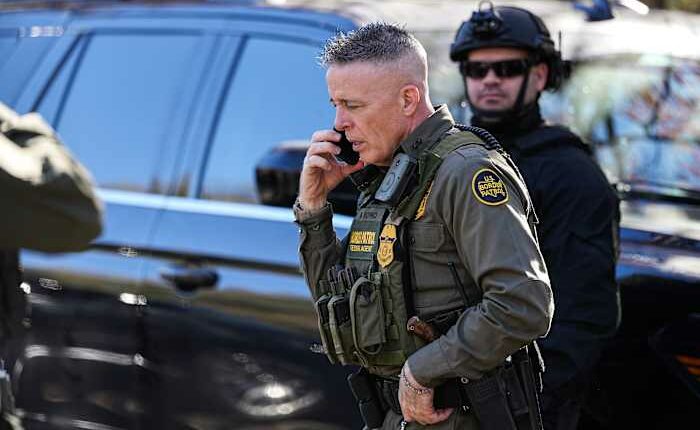Share this @internewscast.com

CHARLOTTE, N.C. – The reach of federal immigration enforcement in North Carolina is set to extend to Raleigh as early as Tuesday, according to the city’s mayor. This comes in the wake of ongoing operations by Customs and Border Protection agents in Charlotte, where over the weekend, more than 130 arrests were made.
Raleigh Mayor Janet Cowell announced on Monday that she was unclear about the scale or duration of the impending operation, noting that immigration authorities had not provided any details. Despite this uncertainty, Mayor Cowell, a Democrat, emphasized her commitment to public safety, pointing out that crime rates in Raleigh have decreased compared to the previous year.
“I urge Raleigh residents to uphold our values and approach upcoming challenges with peace and respect,” stated Cowell in her official announcement.
In Charlotte, North Carolina’s largest city, the weekend saw a significant crackdown, with federal immigration agents apprehending over 130 individuals, according to a federal official on Monday.
This heightened enforcement in North Carolina follows similar immigration sweeps initiated by the Trump administration in major cities like Los Angeles and Chicago. These efforts targeted areas known for their political opposition to the current administration, highlighting a strategic focus on deep blue cities within deep blue states.
Yet, the selection of North Carolina, and specifically Charlotte, as an early target for these operations raises questions about the administration’s broader objectives and strategies in the region.
Sure the mayor is a Democrat, as is the governor, but neither is known for wading into national political battles. In a state where divided government has become the norm, Gov. Josh Stein in particular has tried hard to get along with the GOP-controlled state legislature. The state’s two U.S. senators are both Republican and President Donald Trump won the state in the last three presidential elections.
The Department of Homeland Security has said it is focusing on North Carolina because of so-called sanctuary policies, which limit cooperation between local authorities and immigration agents.
But maybe focusing on a place where politics is less outwardly bloody was part of the equation.
The White House “can have enough opposition (to its crackdown), but it’s a weaker version” than what it faced in places like Chicago, said Rick Su, a professor at the University of North Carolina School of Law who studies local government, immigration and federalism.
“They’re not interested in just deporting people. They’re interested in the show,” he said.
The crackdown
The Trump administration has made Charlotte, a Democratic city of about 950,000 people, its latest focus for an immigration enforcement surge it says will combat crime — despite local opposition and declining crime rates. Residents reported encounters with immigration agents near churches, apartment complexes and stores.
Homeland Security Assistant Secretary Tricia McLaughlin said in a statement that Border Patrol officers had arrested “over 130 illegal aliens who have all broken” immigration laws. The agency said the records of those arrested included gang membership, aggravated assault, shoplifting and other crimes, but it did not say how many cases had resulted in convictions, how many people had been facing charges or any other details.
The crackdown set off fierce objections from area leaders.
“We’ve seen masked, heavily armed agents in paramilitary garb driving unmarked cars, targeting American citizens based on their skin color,” Stein said in a video statement late Sunday. “This is not making us safer. It’s stoking fear and dividing our community.”
Charlotte Mayor Vi Lyles said Monday she was “deeply concerned” about videos she’s seen of the crackdown but also said she appreciates protesters’ peacefulness.
“To everyone in Charlotte who is feeling anxious or fearful: You are not alone. Your city stands with you,” she said in a statement.
The debate over crime and immigration
Charlotte and surrounding Mecklenburg County have both found themselves part of America’s debates over crime and immigration, two of the most important issues to the White House.
The most prominent was the fatal stabbing this summer of Ukrainian refugee Iryna Zarutska on a Charlotte light-rail train, an attack captured on video. While the suspect was from the U.S., the Trump administration repeatedly highlighted that he had been arrested previously more than a dozen times.
Charlotte, which had a Republican mayor as recently as 2009, is now a city dominated by Democrats, with a growing population brought by a booming economy. The racially diverse city includes more than 150,000 foreign-born residents, officials say.
Lyles easily won a fifth term as mayor earlier this month, defeating her Republican rival by 45 percentage points even as GOP critics blasted city and state leaders for what they call rising incidents of crime. Following the Nov. 4 election, Democrats are poised to hold 10 of the other 11 seats on the city council.
While the Department of Homeland Security has said it is focusing on the state because of sanctuary policies, North Carolina county jails have long honored “detainers,” or requests from federal officials to hold an arrested immigrant for a limited time so agents can take custody of them. Nevertheless, some common, noncooperation policies have existed in a handful of places, including Charlotte, where the police do not help with immigration enforcement.
In Mecklenburg County, the jail did not honor detainer requests for several years, until after state law effectively made it mandatory starting last year.
DHS said about 1,400 detainers across North Carolina had not been honored since October 2020, putting the public at risk.
For years, Mecklenburg Sheriff Garry McFadden pushed back against efforts by the Republican-controlled state legislature to force him and a handful of sheriffs from other urban counties to accept ICE detainers.
Republicans ultimately overrode a veto by then-Democratic Gov. Roy Cooper late last year to enact the bill into law.
While McFadden has said his office is complying with the law’s requirement, he continued a public feud with ICE leaders in early 2025 that led to a new state law toughening those rules. Stein vetoed that measure, but the veto was overridden.
Republican House Speaker Destin Hall said in a Monday post on X that immigration agents are in Charlotte because of McFadden’s past inaction: “They’re stepping in to clean up his mess and restore safety to the city.”
Last month, McFadden said he’d had a productive meeting with an ICE representative.
“I made it clear that I do not want to stop ICE from doing their job, but I do want them to do it safely, responsibly, and with proper coordination by notifying our agency ahead of time,” McFadden said in a statement.
But such talk doesn’t calm the political waters.
“Democrats at all levels are choosing to protect criminal illegals over North Carolina citizens,” state GOP Chairman Jason Simmons said Monday.
___
Sullivan reported from Minneapolis and Robertson from Raleigh, North Carolina. Associated Press writers Brian Witte in Annapolis, Maryland and Rebecca Santana in Washington contributed to this report.
Copyright 2025 The Associated Press. All rights reserved. This material may not be published, broadcast, rewritten or redistributed without permission.













